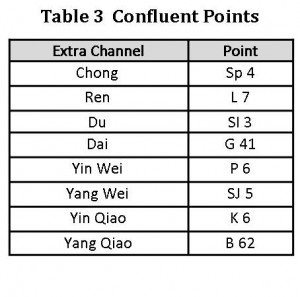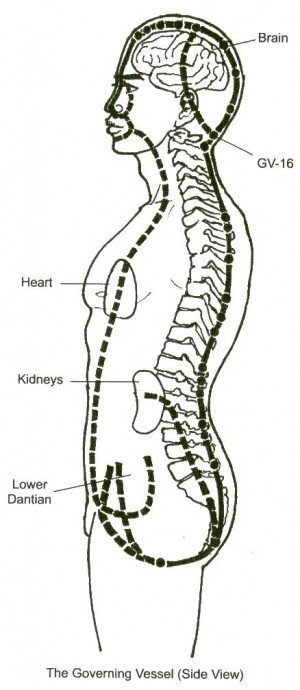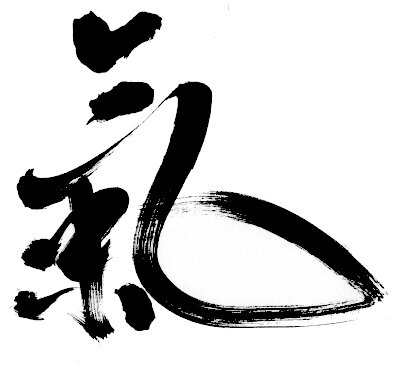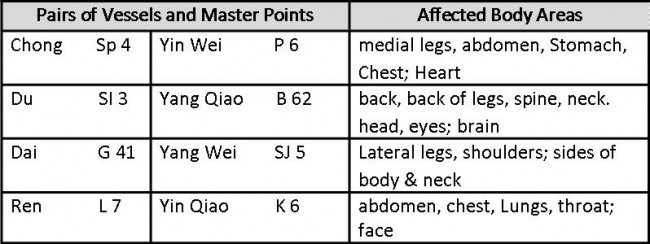The Extraordinary Meridians or Vessels (Part 1)
Marty Eisen Ph.D.
The eight Extraordinary Meridians are: Du (Governing) Mai (Vessel), Ren (Conception or Directing) Mai, Chong (Penetrating, Thrusting) Mai, Yin Wei (Linking) Mai, Yang Wei Mai, Yin Qiao (Heel) Mai, Yang Qiao Mai and Dai (Belt, Girdle) Mai. These Meridians are also known by other names.
(a) Extra Meridians because they were discovered later than the 12 main Meridians and so were considered extra to these. Knowledge of these meridians is ascribed to Li-Shi Zhen (1518- 1593). A book “Qi Jing Ba Mai Chao,” published in 1572, described the Extraordinary Meridians.
(b) Odd Meridians since some of them –e.g. Ren, Du and Dai, are single Vessels and not paired as the regular Meridians. Also, they do not flow out of any of the Zang Fu Organs.
(c) Eight Psychic Channels because they all have a strong effect on psychic and psychological functions.
(d) Miraculous Meridians was coined by the French, who observed therapeutic results on using these, which could not be obtained using the regular Meridians.
(e) Special Meridians because they are Extra and also Miraculous.
(f) Comprehensive Points because their effect is more comprehensive on the body and mind than that of the twelve regular meridians.
(g) Homeostatic Meridians because these meridians maintain homeostasis, as described below.
(h) Ancestral, Prenatal, Pre-Heaven Channels because they help regulate the growth of the embryo and fetus, as discussed in Section 2, and become less active after birth.
2. Chinese Energetic Embryology (2)
The prenatal energies, Jing (Essence), Qi (Energy) and Shen (Spirit), are contained in both the father’s sperm and the mother’s eggs. These three energies in the sperm and egg will be called the Father Qi and the Mother Qi. The combination of Father Qi and Mother Qi is known as Yuan (Original) Qi.
The ovum is polarized at the entry point of the sperm creating an energy vortex. This vortex draws Heaven’s Energy, Earth’s Energy and the Eternal Soul into the egg. It also forms a central column of energy, the Taiji Pole. This polarization also determines the ventral and dorsal surface.
After the first cellular division, the Conception and Governing Vessels appear on ventral and dorsal surfaces, respectively. A left and right side is also established containing the Yin and Yang Heel Vessels. The Yin and Yang Linking Vessels are also formed.
The second cellular division is accompanied by the development of the Belt and Thrusting Vessels.
Each Prenatal Vessel has a role in the embryonic development. The Conception and Governing Vessels control the development of the body’s front and back, respectively. The Thrusting Vessel governs the body’s central core. The Yang (Yin) Heel Vessels control the development of the body’s left and right Yang (Yin) energy. The Yang (Yin) Linking Vessels control the development of the exterior (interior) of the body (and correlates to Heaven (Earth) Energy). All of the channels are bound together by the Belt Channel.
During the formation of the embryo the 6 Yang Regular Meridians arise from the Governing Vessel as well as the Yang Heel Vessels, Yang Linking Vessels and Belt Vessel. Also, the 6 Yin Regular Meridian, Yin Heel Vessels, Yin Linking Vessels and Thrusting Vessels emerge from the Conception Vessel.
The mother’s Meridians carry Qi that nourish and create the development of the baby. The ten Lunar months of creation are described in (2).
For proper treatment, a Qigong doctor should know energetic fetal development in order to diagnose the origin and causes of a disease as congenital or acquired.
After birth, the energy in the Extra Meridians slows down considerably. They serve as reservoirs of Qi. One of the stages in the Daoist practice of Nei Gong is to reverse this process and restore a healthy movement in the congenital Vessels.
3. Some General Properties of the Extra Meridians (2,3)
(a) Qi Reservoirs
They can absorb energy from the Ordinary Meridians and also supply energy to them when required – for example, in the event of shock.
(b) Store and Circulate Jing
They draw their energy from the Kidneys. These Vessels contain Essence, which is stored in the Kidneys, and circulate it around the body. This helps combine the circulation of Nutritive Qi with Essence. In particular, they circulate Jing to the skin, hair, and Curious Organs.
Since they circulate Essence all over the body and are connected to the Main Meridians, they are a link between the Pre-Heaven and Post-Heaven Qi. Thus, they can be used for treatments related to the Pre-Heaven Qi and the individual’s constitution.
(c) Link the Six Curious (Extraordinary) Organs with the Body’s Internal Energy
The Extraordinary Vessels provide the link between the body’s energy flow and the Curious Organs. The six Curious (Ancestral) Organs are: Marrow, Blood Vessels, Bone, Brain, Gall Bladder, and Uterus.
Their regulating Vessels appear in Table 1. 
(d) Regulate the Body’s Life Cycles
The life cycles in men (every 8 years) and in women (every 7 years) are governed by the Thrusting and Conception Vessels, respectively. These cycles are determined by Jing, which is circulated by the extraordinary Vessels.
(e) Circulate Wei (Protective) Qi
The Conception, Governing, and Thrusting Vessels are primary responsible for circulating Wei Qi over the abdomen, thorax, and back. Although Wei Qi is circulated by the Lungs, its root is in the Kidneys. The Extra Vessels derive from the Kidneys and so provide the link between the Kidney Jing and the Wei Qi. This explains why the immune system can become vulnerable to Evil Pathogens and allergic reactions when there is a Kidney deficiency.
(f) Link the Body’s Seas and Internal Energy Flow
The Ling Shu, Hai Lun (Magic Pivot) describes the Four Seas, their regulating Vessels and their Access Points as well as symtoms of Excess and Deficiency. See Table 2.
The Sea of Blood is also related to the Liver and the Sp 10 (Xue Hai).
Some Qigong schools state that there are two Seas of Qi. The Sea of Postnatal Qi is the Middle Dantian, which is regulated by Ren 17. They call the Lower Dantian, the Sea of Prenatal Qi and it is regulated by Ren 6.
Some acupuncture schools name three other Seas. The Sea of the Yang Meridians is governed by the Du Meridian. The Sea of the Yin Meridians is regulated by the Ren Meridian. The Sea of Blood is called the Sea of the Regular Merid ians and is governed by the Chong Meridian (4).
ians and is governed by the Chong Meridian (4).
(g) Confluent Points
These are points that are located on the Twelve Primary Meridians through which the Eight Extra Meridians can be accessed.
4. Generalities on the Clinical Use of the Extra Vessels (1, 3)
These Vessels can be grouped in a few different ways for clinical use.
The first grouping is into four pairs of Yin and Yang Vessels according to their polarity, as shown in Table 4. Each member of a pair has a Master or Opening Point which affects the Channel’s energy flow to different body areas.
Table 4. Pairs of Vessels, Master Points and Affected Body Areas
The Master Point of the main meridian being treated (due to symptomology) is needled first and then its coupled Master Point is needled. In males, it is common to needle the Master Point on the left side and the coupled Master Point on the right. For females, it is common to needle the Master point on the right side and the coupled Point on the left. For example, if the Governing Vessel was being treated in a man, L 7 would be needled first on the left and then K 6 on the right. In a woman, L 7 would be needled first on the right and then K 6 on the left (1, 3).
The Extra Vessels can also be arranged into four groups according to their functions.
(a) Conception, Governing and Thrusting Vessels
These Vessels originate from the Kidneys and so are connected to the Essence. These can be used more often than the other Extraordinary Vessels to affect energy at a deep constitutional level.
(b) Yin and Yang Heel Vessels
The Yin Heel Vessel carries Yin energy to the eye while the Yang Heel Vessel carries Yang energy to the eye. If the energy in the Yin Heel Vessel is in Excess one will be constantly sleepy. If the energy in the Yang Heel Vessel is in Excess one will be awake with open eyes.
These Vessels also control the leg muscles. If the Yin Heel Vessel is diseased, the muscles of the inner (Yin) sides of the legs are tight and the muscles of the outer (Yang) sides of the legs are loose. If the Yang Heel Vessel is diseased the muscles of the inner (Yin) sides of the legs are loose and the muscles of the outer (Yang) sides of the legs are tight.
(c) Yin and Yang Linking Vessels
These Vessels link the Yin and Yang Channels. Their Master Points are on the Triple Burner and Pericardium Meridians, which are also internally/externally related.
(d) Belt Vessel
This is the only horizontal Meridian. It has an influence on the energy circulation in the legs because it encircles all the ordinary Meridians.
The Extraordinary Vessels can also be grouped by their distribution of energy through the central axis of the body and three perpendicular planes.
The Thrusting Vessel starts from the Kidney and distributes energy to the central core of the body. Its energy is also distributed by small channels carrying Defensive Qi to the Yin and Yang Linking Vessels, Yin and Yang Heel Vessels, and also to the Girdle Vessel. Thus, these five Vessels originate from the Thrusting Vessel.
The Conception and Governing Vessels lie in the midsagittal plane of the body, the Yang Heel and Linking Vessels define the coronal plane and the Belt Vessel influences a transverse plane.
The path and function of each Extraordinary Vessel is discussed in the following sections.
5. The Governing (Du) Vessel
In Pinyin Du means governing. This Channel governs the formation of the cerebrum and medulla oblongata during embryonic development. Recall that it is called the Sea of the Yang Meridians because it controls all the Yang Channels. It nourishes the brain and spinal cord, helps in combining the Yuan (Original) Qi of the Kidneys and tonifies the Kidney Yang. The Du Meridian strengthens the spine and back. If the Du Meridian becomes excessive, the back is stiff. If it is depleted, the head becomes shaky, heavy and unstable.
The primary pathway of the Du Meridian originates in the Lower Dantian (2) (Figure 1) .Some acupuncturists state that it originates in the Kidneys (1, 3) because of its clinical effects. It emerges to the surface of the body at Du1 (on the midline, midway between the tip of the coccyx and the anus) and then ascends along the midline of the sacrum and through the interior of the spinal column. It runs along the midline of the neck and head to the crown of the head at Du 20 (Bai Hui, on the midline of the head, 5 cun directly above the midpoint of the anterior hairline, approximately on the midpoint of the line connecting the apexes of both ears). From Du 20 the channel descends along the midline of the forehead and nose to its final point, Du 26 (above the upper lip on the midline, at the junction of the upper third and lower two thirds of the philtrum).
As the main branch begins to run up the spinal column a branch diverges from it, also runs up the spinal column and enters the Kidneys (Figure 1).
Another branch emerges at Du 16 or GV-16 (Feng Fu, on the midline at the nape of the neck, in the depression immediately below the external occipital protuberance) , enters the brain and ascends to Du 20.
Another set of branches from the perineum, encircle the anus, envelops the external genitalia, ascend past the navel, Heart and throat and wind around the mouth. After circling the mouth, they ascend to the eyes and emerge just below the middle of the eyes. See Figures 1 and 2.  Figure 2. Some Branches of the Governing Meridian
Figure 2. Some Branches of the Governing Meridian
From the inside of the eyes at Jingming (B1, .1 cun medial and superior to the inner canthus of the eye, near the medial border of the orbit), branches follow the Bladder Meridian up the forehead and converge at Du 20. There the Vessel enters the brain and emerges at Du 16 where it divides into two branches. These descend, pass through the Fengmen points (B 12, 1.5 cun lateral to the Du Meridian, at the level of the lower border of the spinous process of the second thoracic vertebra) and enter the Kidneys. See Figure 2.
Different Nei Gong schools may list different branches, depending on the types of Qigong they practice. Acupuncture texts only list they main branch, since its points are accessible to needling (3, 4), while the other branches are only accessible to the mind.
6. Functions and Uses of the Du Meridian
Some functions of the Du Meridian appear in Table 5.
Table 5. Some Functions of the Du Meridian
The Du Meridian can be used for the following problems.
(a) The Du Meridian is useful for chronic lower backache due to Kidney Deficiency. The back can be strengthened and the spine actually straightened. In men, only the Governing Vessel can be used, but in women it is best to also use the Conception Vessel. Knee and leg pain can also occur.
(b) To expel Wind: For Exterior Wind it can be used to release to the Exterior at the Greater Yang stage of The Six Stages. Therefore, it can be used for symptoms like runny nose, fever, headache and a stiff neck. Interior Wind can also be subdued by using the Du Meridian. Thus, it is used for symptoms such as tremors, dizziness, convulsions, epilepsy and for the results of Wind Stroke.
(c) The Governing Vessel can be used to strengthen the Kidney function of nourishing Marrow and the Brain. Hence, it can treat symptoms like tinnitus, dizziness and poor memory.
(d) For ear, nose, and throat problems of unknown origin such as swollen glands, unclassified throat disease, and vague tooth pains.
(e) Since the Du Meridian is connected to the body’s Jing (Kidney), Qi (Heart) and Shen (Heart), it can treat depression, madness, slow recovery after shock, lack of mental stability, lack of vitality, pure and impure thoughts; hallucinations.
(f) For urogenital problems such as urinary retention, piles; nocturnal enuresis
(g) For diseases of the head (tetanus, apoplexy, aphasia, epilepsy, etc.), back and neck (pain and stiffness in the spinal column), spastic movement of the extremities; gastrointestinal problems (pain; Qi rushing up into the abdomen), all resulting from an Excess condition in the Du Meridian.
(h) For a heavy feeling and shaking of the head, irritability, inability to concentrate, poor physical and mental stamina, weak character, sterility or impotence, which can all result from a Deficient condition in Governing Vessel
 Marty Eisen, PhD, is a retired scientist, who constructed mathematical models in medicine. He has studied and taught Yoga, Judo, Shotokan Karate, Aikido, Qigong, Praying Mantis Kung Fu, and Tai Chi. Dr. Eisen studied Chinese Medicine through apprenticeships and correspondence courses. His new Amazon Kindle and hard copy books “Healthy Exercise for Seniors and Non-Athletes” describes classical Yoga, Tai Chi and Qigong to encourage practitioners to learn more about these arts. For more information about Dr. Eisen please visit http://home.comcast.net/~carolezak
Marty Eisen, PhD, is a retired scientist, who constructed mathematical models in medicine. He has studied and taught Yoga, Judo, Shotokan Karate, Aikido, Qigong, Praying Mantis Kung Fu, and Tai Chi. Dr. Eisen studied Chinese Medicine through apprenticeships and correspondence courses. His new Amazon Kindle and hard copy books “Healthy Exercise for Seniors and Non-Athletes” describes classical Yoga, Tai Chi and Qigong to encourage practitioners to learn more about these arts. For more information about Dr. Eisen please visit http://home.comcast.net/~carolezak





8 Responses to The Extraordinary Meridians or Vessels — Part 1